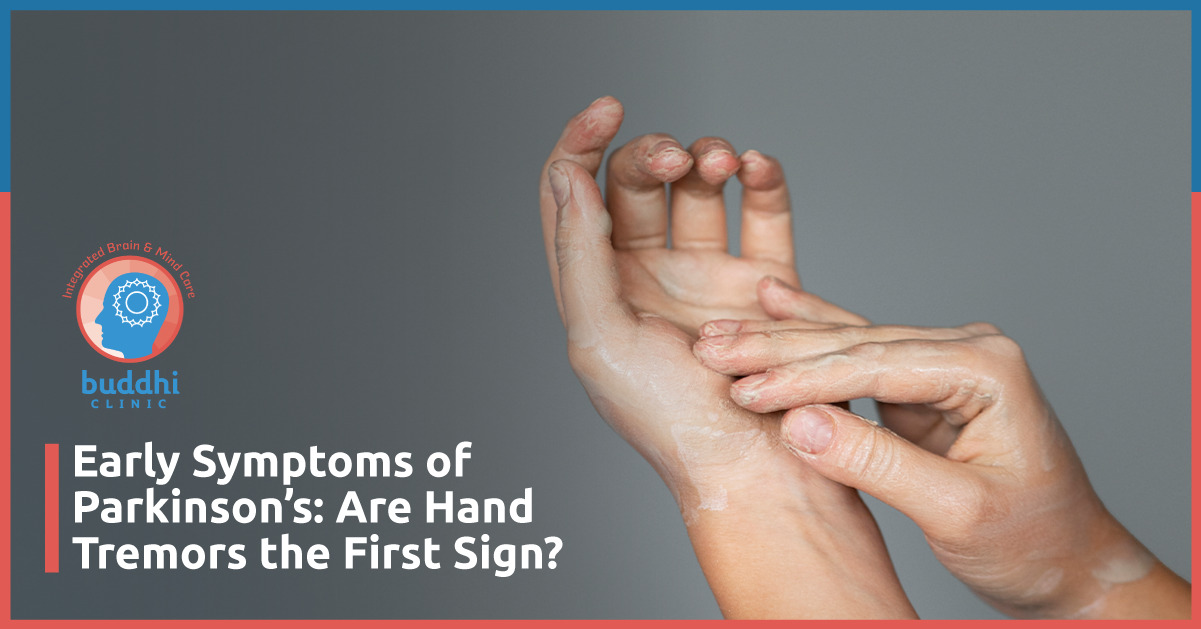Introduction
Parkinson’s disease (PD) is commonly linked to hand tremors, but is that actually the initial indicator? Most individuals believe that trembling hands are the first sign, but Parkinson’s can present itself in subtle forms well before tremors show. Identification of those early symptoms of Parkinsons is crucial for early intervention, which can retard disease development as well as enhance quality of life.
This blog discusses Parkinson’s disease, its warning signs, and the latest treatment options at Buddhi Clinic.
What is Parkinson’s Disease?
Parkinson’s disease is a neurodegenerative disorder due to the progressive loss of dopamine-producing neurons in the brain. Dopamine is the neurotransmitter that is responsible for smooth and coordinated muscle movements, and its depletion results in motor and non-motor symptoms.
Causes of Parkinson’s Disease
While the exact cause remains unclear, contributing factors include:
- Genetic mutations (such as LRRK2 and SNCA genes).
- Environmental toxins (pesticides, heavy metals).
- Aging-related neuron loss.
- Head trauma (repeated injuries may increase risk).
Types of Parkinson’s Disease
- Idiopathic Parkinson’s Disease: The most common form, with no known cause.
- Secondary Parkinsonism: It is caused by medications, toxins, or brain injury.
- Atypical Parkinsonism: It comprises Lewy body dementia and progressive supranuclear palsy.
Parkinson’s disease understanding assists in early detection and proper control.
Early Symptoms of Parkinson’s: Are Hand Tremors the First Sign?
Parkinson’s disease (PD) is usually identified by its signature symptom, hand shakin, but these aren’t always the initial indication. Most patients go through subtle alterations in movement, sleep, handwriting, and even sense of smell before becoming apparent shaking happens. Recognizing the warning signs can result in early diagnosis and treatment, slowing the onset of symptoms and increasing long-term quality of life.
1. Tremors: The Classic Symptom
Tremors are one of the most characteristic symptoms of Parkinson’s, but they may not be the first to show. Tremors caused by Parkinson’s are distinct from those brought on by anxiety or fatigue. They usually occur as:
- Resting tremors: Shaking when the hand is at rest, fading away when doing something.
- Finger or thumb trembling: Small, rhythmic motions can begin very subtly before advancing to become more obvious shaking.
- Shaking that becomes more severe with stress or fatigue: Tremors will sometimes worsen at emotionally charged times or when the individual is fatigued.
Although tremor is a significant diagnostic sign, patients may have other changes in their neurological function before experiencing tremor.
2. Tiny Handwriting (Micrographia)
Handwriting changes can be among the first indications of Parkinson’s:
- Handwriting gets progressively smaller and more cramped, frequently getting progressively smaller as sentences go on.
- Letters appear to be set closer together, making it hard to keep things legible.
- Some people report having trouble keeping handwriting size and control consistent.
Micrographia results from bradykinesia (reduced movements) in fine motor control. As writing demands accuracy and coordination, these alterations might be the earliest signs before the onset of other symptoms.
3. Decreased Sense of Smell (Hyposmia)
The reduced capacity to identify some odors may develop several years prior to the onset of motor symptoms. Patients may remark:
- Trouble recognizing common odors, like food odors, perfume, or air fresheners.
- Diminished ability to distinguish among different odors.
- Slow loss of interest in foods and spices, as smell contributes significantly to the sense of taste.
Loss of sense of smell is associated with degeneration of the olfactory system, and this is occurring early in Parkinson’s. Loss of sense of smell, while an early marker, goes unappreciated because it isn’t affecting motor function directly.
4. Sleep Disturbances
Brain function concerning the regulation of sleep is affected in Parkinson’s disease, which in turn can bring about the disturbances of:
- Acting out dreams (thrashing, talking, or movement in sleep from REM sleep behavior disorder).
- Restless leg syndrome, resulting in uncomfortable feelings and a desire to move legs at night.
- Difficulty sleeping, with many awakenings or poor quality sleep.
Sleep symptoms usually precede movement symptoms, so they are a significant observation area for early diagnosis.
5. Rigidity & Struggling to Move (Bradykinesia)
Bradykinesia is slow movements, an early symptom of Parkinson’s that affects mobility. The signs are:
- Muscle rigidity which doesn’t resolve with movement.
- Decreased arm swing while walking, resulting in movement being stiff or uneven.
- An inability to lift feet off the floor, leading to dragging or pausing while walking.
Patients can experience difficulty with everyday tasks, like buttoning shirts or rising from chairs. Because stiffness can be confused with normal aging, it is crucial to pay attention to whether symptoms worsen or persist over time.
6. Speech & Facial Expression Changes
Speech and facial expressions can become less active because of changes in muscle control caused by Parkinson’s. Symptoms include:
- Slurred or soft speech, which makes it more difficult to follow conversations.
- Decreased facial expressions (termed “masked face”), giving the appearance of a blank or serious face.
- Trouble getting conversations started, with slow verbal responses.
These signs are caused by muscle rigidity in the vocal cords and facial muscles, and they can manifest early during the course of the disease.
7. Postural Instability & Balance Difficulty
Parkinson’s disease impacts balance, posture, and coordination, at times occurring prior to the onset of tremors. Warning signs are:
- Slouched posture, causing movement to feel slow.
- Frequent falling, especially in new situations or during turning.
- Slowness of movement (bradykinesia) that interferes with walking, standing, or pivoting.
As posture control declines, persons will need to use assistive devices to avoid falling and maintain stability.
Why Early Identification Matters?
Parkinson’s develops slowly, i.e., symptoms begin unobtrusively before affecting daily life. Identifying these early warning signs provides the possibility of:
- Early medical treatment, slowing down progression.
- Improved control of symptoms using drugs and therapy.
- Enhanced quality of life, as the affected get the support early before the onset of worsening symptoms.
Because Parkinson’s symptoms manifest differently in every individual, early detection guarantees an individualized treatment process for long-term care.
Parkinson’s Disease Treatment at Buddhi Clinic
Buddhi Clinic excels at thorough Parkinson’s treatment with a multigenerational method of symptom management. Their treatment involves:
1. Neurotherapy & Neuromodulation
- Transcranial Magnetic Stimulation (TMS) for increasing levels of dopamine.
- IFES therapy to improve muscle control and reduce tremors.
2. Physiotherapy & Gait Training
- Strengthening exercises to improve mobility.
- Posture correction to reduce falls.
3. Speech & Swallowing Therapy
- VitalStim therapy to strengthen vocal and swallowing muscles.
- Speech clarity exercises for better communication.
4. Medication Management
- Levodopa therapy to replenish dopamine.
- Dopamine agonists to improve motor function.
5. Holistic Care & Lifestyle Interventions
- Dietary guidance to support brain health.
- Mind-body therapies for emotional well-being.
Conclusion
While tremors in hands are a general symptom of Parkinson’s, they do not necessarily occur first. Small handwriting, loss of odor, sleep troubles, and stiffness are early symptoms that can surface years before tremors set in. Identifying them early permits early intervention and enhances long-term outcomes.
Advanced Parkinson’s care is provided at Buddhi Clinic with the fusion of neurotherapy, physiotherapy, and holistic treatment for better mobility and independence.
If you or someone close to you has initial symptoms of Parkinson’s, consultation with the expert can go a long way.
FAQs
1. Is Parkinson’s disease curable?
No, but intervention in the initial stage can impede progression and enhance quality of life.
2. Does hand trembling result as an inaugural symptom of Parkinson’s?
No, loss of sense of smell, tiny writing, and stiffness can occur initially.
3. What is the treatment Buddhi Clinic provides for Parkinson’s disease?
Buddhi Clinic provides neurotherapy, physiotherapy, speech therapy, and medication management.
4. What are the lifestyle modifications that manage Parkinson’s?
Exercise daily, eat a healthy diet, and manage stress to have better symptoms.
5. When do I need to see a doctor about Parkinson’s symptoms?
If you experience ongoing tremors, stiffness, or difficulty with balance, see a specialist right away.






